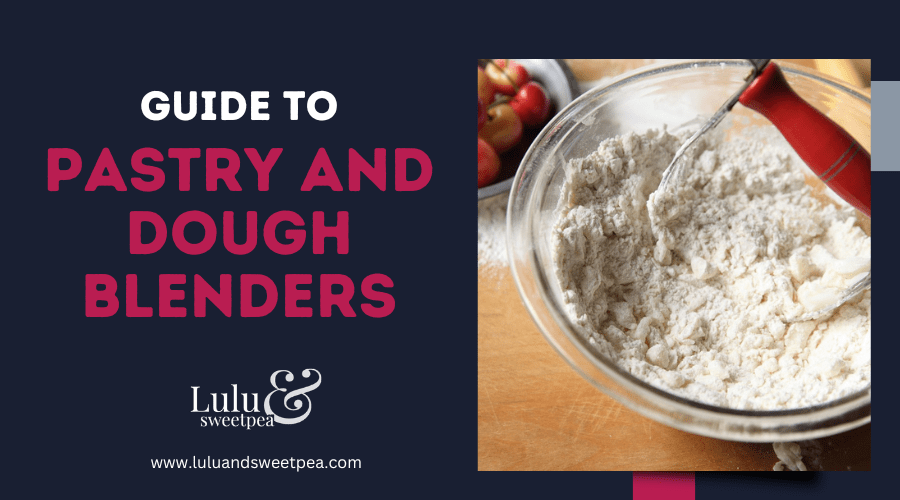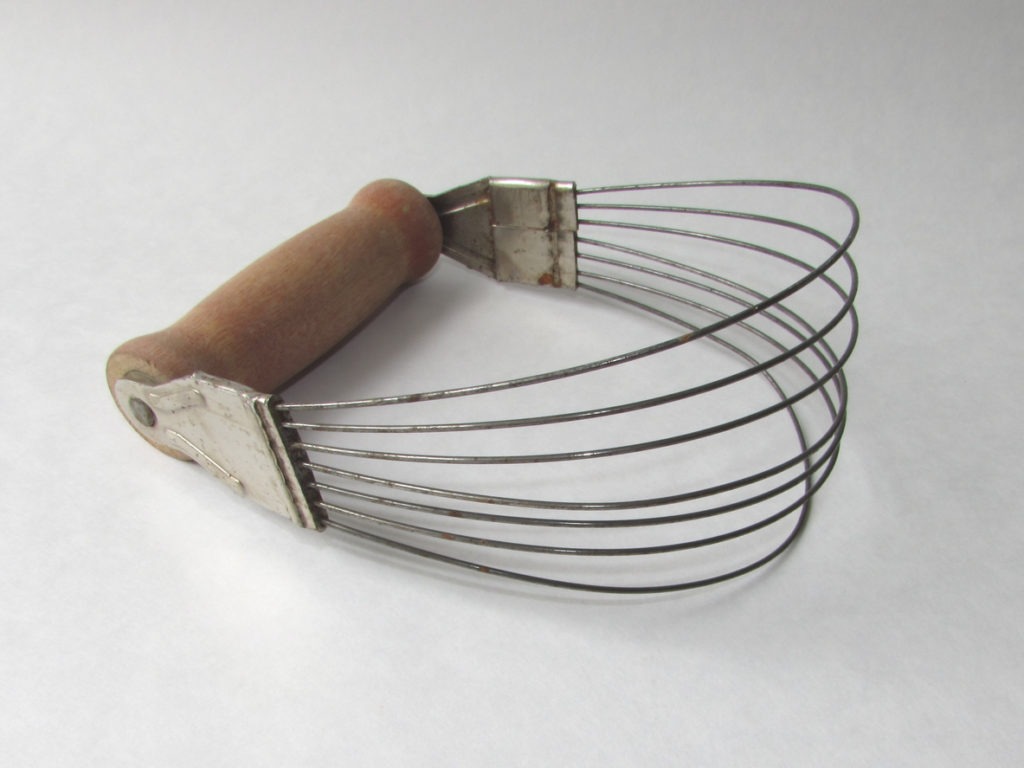For generations, bakers have been mixing fat into flour – either with their hands, food processors, or pastry blenders. Pastry blenders, which is also called pastry cutter, is one of the humblest tools in the kitchen and one of the best ones to use for that job. It’s a simple kitchen tool, but it makes it easy to mix cold butter, lard, or shortening into flour to make a perfectly tender and flaky dough. And we all know that dough can be hard to perfect, especially for beginner bakers.
What is a Pastry Blender?
A pastry blender (also known as a pastry cutter) is a handheld cooking tool that helps mix hard fat in the flour. It is made of wires or narrow metal stripes that are attached to a handle. To use it, you must press the metal blades or stripes to the hard fat to break it into smaller pieces. O
It’s not a necessity, but it’s a valuable tool if you plan to work more with the dough in the future. Of course, you can get the work done using other tools, and you may simply knead the dough with your hands, but a pastry blender ensures that the butter won’t become a melted mess in your hands when you’re blending it with the flour. It’s perfect for making tender and flaky crusts for your pies, cookies, cakes, and pastries.
Types of Pastry Blenders
There are two main types of pastry blenders that serve different purposes. Most chefs prefer to have both in hand for different food preparation and cooking tasks.
1. Blending cutter
It’s a pastry cutter with four to five U-shaped blades that is best used for cutting butter or shortening to mix into dry ingredients. The thickness of the blades varies across models, as well as the durability of the blender. These need a little bit of force to use, so they must be easy and comfortable to grip.
2. Cutting wheels
Sometimes called ravioli wheels, these tools are smaller and more intricate. It can cut and crimp pastries and pasta dough and create delicate designs. It can be used for cutting up pasta to make ravioli or create a lattice on a pie. Cutting wheels come in different sizes, with one or two wheels included to offer cutting options. The wheels must spin smoothly, and the handle must be comfortable.
Both blending cutters and cutting wheels can be made of wire or metal. Some pastry cutters use thin wires with a metal coating, while some come with thick blades made of stainless steel or other high-quality metal materials.
Benefits of Using a Pastry Blender
If you like making homemade pastries, a pastry cutter would be an invaluable tool to get the job done easier and prevent making your hands dirty.
1. Buttery crust
Who doesn’t like a flaky, buttery crust with pies and other pastries? A pastry blender can help you blend butter or lard with your dough better to ensure you get the flaky, buttery layers in the crust you like.
2. Even distribution of ingredients
A pastry cutter helps distribute the butter evenly throughout your dough for baking pastries, biscuits, and cakes.
3. Versatile
Besides baking pastries, a pastry cutter is a versatile tool that can be used for other purposes. A high-quality pastry blender can mix and mash a variety of ingredients, including side dishes and dips like mashed potatoes, hummus, and guacamole. It can help you roll your dough, mash ingredients for your spreads, whip up pie crusts, and even crush fruits for a smooth and tasty recipe.
4. Easy to clean
Most pastry cutters are dishwasher-safe and relatively easy to clean by hand – just be careful with the blades so you don’t accidentally cut yourself.
5. Better option than a food processor
A food processor is used for making dough for a faster, more hands-on approach. However, some bakers do not like using food processors for pastries because it can overwork the dough. With food processors, you lose control over the delicate blending of the butter and flour, and the warmth of the motor running can also heat up the butter and break down the milk fat. Also, food processors tend to be bulky and harder to clean. Though it may require more work, a pastry blender is a more effective and efficient tool as compared to a food processor.
Factors to Consider when Buying a Pastry Blender
Whenever you want to buy a pastry cutter, here are some features you may want to look for:
Quality
When buying a pastry blender, quality must always be your top priority. The dough can be hard to blend, and going for a cheaper blender won’t give you the strength needed and probably won’t last very long. You want to make sure that the blades are sturdy, as well as the handles, so you won’t accidentally get hurt from the handle coming loose or the blades flipping around to your hand. Many quality options are long-lasting. For the best quality, choose one with stainless steel blades and a handle that is made of steel, rubber grip, or durable wood.
If you’re looking for a pastry blender in person, try moving the blades back and forth to ensure they won’t flex when using it.
Grip
Comfort is one of the most important factors to consider when choosing a pastry blender. When you’re working with dough, your hands and wrists already suffer fatigue after a while. You want it to be durable enough to withstand a lot of pressure since you will be handling dough, but you also want it to be comfortable enough to grip. You don’t want to strain your hands preparing pasta or crust for an hour, only to repeat it again and again.
A rubberized handle can cut down on fatigue, as it provides cushioning to keep your hands comfortable. Wood looks pretty and is inexpensive, but it has a hard grip and is not dishwasher-safe. Plastic also offers more secure handling than rubber, though it may not last as long. Ergonomic design handles are also an excellent choice for chefs with arthritis or joint pain, or if you will be cooking or baking in bulk.
How comfortable your grip might be would also depend on the size of the pastry blender compared to your hand. Some pastry cutters come in multiple sizes, giving you more options to make a pastry cutter easier to maneuver.
Blades
The blades are another crucial factor to consider. Seek out blades that are made from food-grade stainless steel because they are safe, rust-proof, and durable. Durable blades will cut through cold butter easily and are typically dishwasher-safe. Still, any metal blades are preferred instead of wire options. Wire pastry blenders are inexpensive and common, but they may struggle to get through some shortening and may even snap or break over time.
The thickness of the blades also has a bearing. Some pastry blenders advertise thin blades, while some promote the durability of thicker blades. But thin, sharp blades are the most effective in cutting through the sticky dough and hard butter so it might be a more versatile option.
Cost
Pastry blenders are inexpensive baking utensils, and while you may be able to afford to pay a little more for a durable one – don’t go crazy with it. A pastry blender is such a simple piece of equipment that spending a lot on it won’t be necessary.
Cleaning
Baking requires a lot of effort, and you always end up with too many tools to clean. There are mixing bowls, whisks, oven, trays, and on top of that, a pastry blender. The good thing is that pastry blenders are often dishwasher-safe, especially those made with stainless steel. And when compared to a food processor, they are certainly less complicated to clean.
Purpose
It’s a better value for your money if your choice of pastry blender can adapt to the other features that a normal masher or blender can do. A good pastry blender can crush nuts, boiled eggs, fruits, and vegetables.
Additional tools included
You can find a lot of pastry cutters that are sold in sets that include a cookie or biscuit cutters. If you only need a pastry cutter, this type of bundle probably won’t help you, but it’s worth considering if you think you might make cookies and biscuits in the future. Some biscuit cutters are even available in different sizes to allow customized baking.
Left-handed usage
Some pastry cutters are designed using right-handers in mind, as they are angled slightly to favor those wielding the tool from the right side. But if you’re left-handed, see to it that the tool can cater to both sides or be used comfortably and efficiently by left-handed people without sacrificing comfort.
Colors
While this won’t affect the pastry blender’s performance, you may opt for a specific color when available on the handle. You can choose from colors that can complement your décor or bring a slight accent to your kitchen.
How to Use a Pastry Blender
1. Start with cold butter
When working with dough, always start with very cold butter to about 1-inch cubes. Add the butter to your dry ingredients and start cutting right away. Work with it immediately and don’t let the butter sit out while you take care of other tasks, because you will over-mix it. Once you start cutting in the butter, keep going until you reach the desired consistency.
The goal is that the butter must still be solid when you put your pastry into the oven. Start with the butter straight from the fridge to prevent it from softening too much.
2. Add the cubed butter to the dry ingredients
Cube your cold butter first, then set it back in the fridge while you prepare your dry ingredients. Add dry ingredients like sugar, flour, and salt to the bowl and mix them quickly together. Then, add the cold, cubed butter to blend and cut immediately.
3. Mix continuously
While mixing, you might feel the need to stop and scrape the butter from the tool. But since time is of the essence, you need to keep going, and the butter will come out on its own as you keep on mixing.
However, be careful not to over-mix. Unlike other kinds of dough, you don’t want to fully incorporate the butter into the dry ingredients. Go for small lumps of butter coated in flour. And make sure you’re not overdoing it by keeping an eye on your progress.
Aside from pastry blenders, there are also other types of blenders to choose from. If you need help, you may read our Guide to Choosing the Right Blender for Your Needs for the best recommendations.


